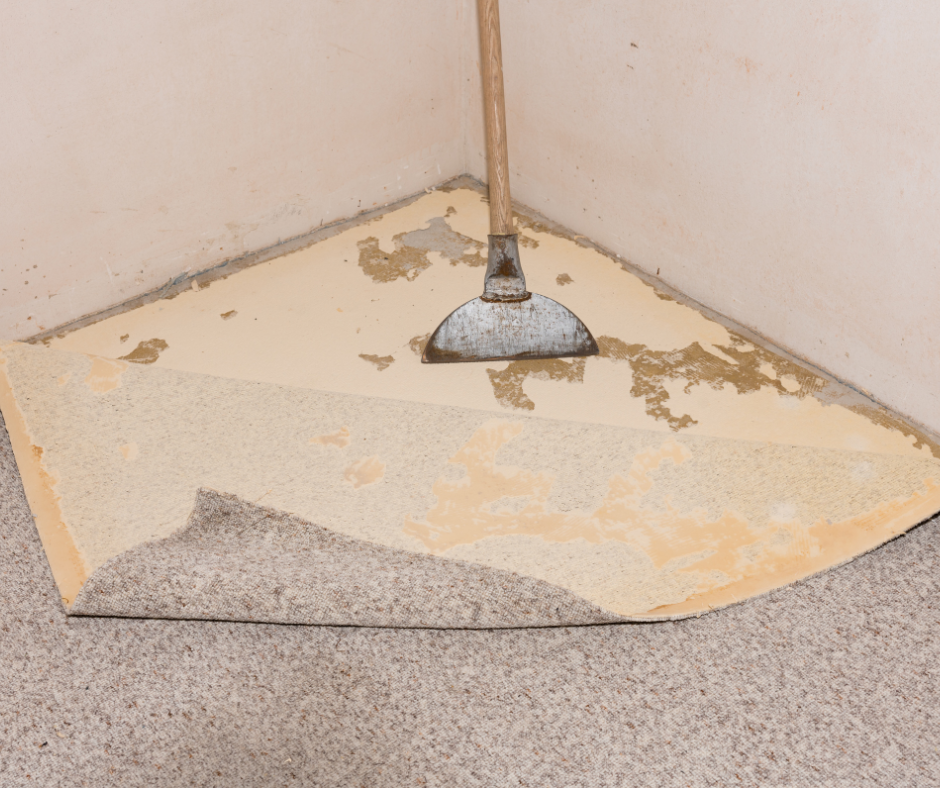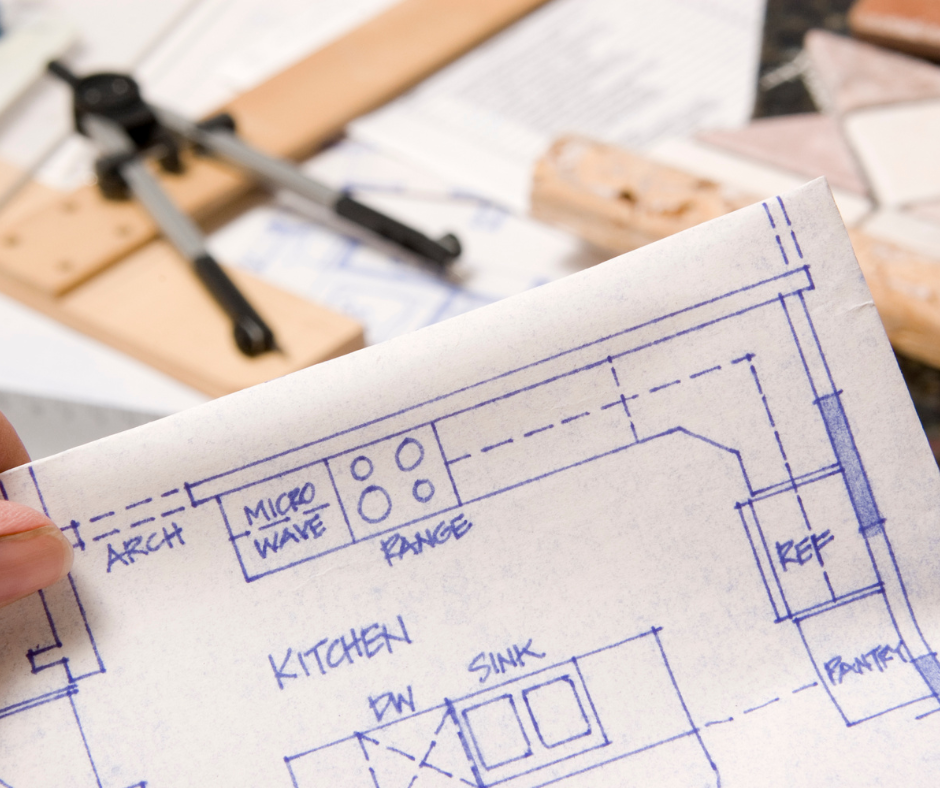September 3rd, 2024 by tisner

Homeowners of houses built in the wall-to-wall carpet phase may be pleasantly surprised to learn that there is hardwood flooring beneath rug. If you’ve pulled up a corner of the carpeting and found just that, or simply want to remove the old carpet before new is installed, DIY’ing this job is a good idea, but be ready–here are a few tips for removing wall-to-wall carpeting:
- You’ll need a few things–heavy duty trash bags, protective gloves, sharp utility knife, dust mask, and a crowbar, and for removing padding glue or staples, a flat floor scraper or padding adhesive remover.
- Remove all the furniture from the room, as well as floor vents, and any under shoe molding. Vacuum very well to remove as much dirt and dust as possible.
- If there is a room door that swings inward, take the door off the hinges to keep it out of the way.
- Suit up with the dust mask and the work gloves, and start in a corner, pulling a section back with the crowbar, taking care to be mindful of the tack strips that can be holding down the carpet around the perimeter of the room.
- Once you’ve pulled the carpet back, fold it over, and, using the utility knife, cut a section of carpet from the back side for easier going. (Cutting the large rug into sections makes it much more manageable than rolling up the whole piece.)
- Remove the tack strips with the crowbar if you have hardwood floors under the padding that you plan on refinishing. Start in the middle of the strip, loosening the nails, and work towards the ends.
- After the tack strips are out, tackle the padding. Pull it up, cutting into sections the same way the carpet was cut.
- Some padding is installed with adhesive, and some is stapled to the floor. If there is glue remaining on the floor, follow the instructions on the carpet padding adhesive remover to get the glue off the flooring. The staples can be removed with the floor scraper.
- Remember that if you’re planning on recarpeting the floor, leave the tack strips in place, and remove the padding anyway, as most installers require new padding to be put down.
Call your local municipality to find out how they would like for you to dispose of the old carpet, because the large amount may not be able to be picked up by the regular truck. Don’t hesitate to ask about recycling programs that are available, as virtually all carpeting can be recycled.
Access Teri’s one-stop Orlando FL home search website.
Teri Isner is the team leader of Orlando Avenue Top Team and has been a Realtor for over 24 years. Teri has distinguished herself as a leader in the Orlando FL real estate market. Teri assists buyers looking for Orlando FL real estate for sale and aggressively markets Orlando FL homes for sale.
You deserve professional real estate service! You obtain the best results with Teri Isner plus you benefit from her marketing skills, experience and ability to network with other REALTORS®. Your job gets done pleasantly and efficiently. You are able to make important decisions easily with fast, accurate information from Teri. The Orlando Avenue Top Team handles the details and follow-up that are important to the success of your transaction.
Tags: carpet, carpeting, flooring options, hardwood floors, home improvements, homeowners, orlando avenue top team, removing carpet, Teri Isner, wall-to-wall carpet
Posted in Home Tips from Teri | No Comments »
August 27th, 2024 by tisner

The large dining room, family room or bonus rooms was one of the things that sold your house to you. Despite our good intentions, though, those rooms sometimes end up being used for storage, folded laundry, or just not being used altogether. Use these ideas to inspire you to get these rooms ready to spend more time in:
Extra Bedroom
Most extra bedrooms end up being the guest room, whether you have guest often or not. Turn that room into a dual-purpose room; use a daybed with trundle or a wall bed so you’ll have more space in the room for other things.
- Set up a home office or study space for the kids.
- Add a small double-leafed or card table, use stackable or folding chairs, install some shelving, and have the room serve as the game/play room.
- If your children like to invite friends over for video games, hang a flat screen on the wall, a small shelf for their game console, lay a cushy area rug on the floor, and purchase bean bag chairs, slip chairs are large floor pillows for seating.
- Create a reading room with a small bookshelf, a comfy chair, blanket, small side table and lamp.
Bonus/Flex Room
You couldn’t wait to start decorating and using your extra room, but you’re stumped on exactly what to do.
- Get the television out of your living space, get some affordable seating, and create a home theater.
- Do you have a musician in the family? Soundproof the walls, add extra electrical outlets, and clear the floor for your own concert hall.
- Give your workout equipment a home in the extra room, use a small television for workout entertainment, install a comfortable bench, hooks for small towels, and include a small fridge for water and smoothies when you’re finished with exercising.
Not Just for Dining
Busy families don’t always have time for a sit-down meal at the dining table, but there’s no need to use it for special occasions.
- Use one end of the table for office space. A dining room is less busy than other rooms, and you can get more done there without distractions. Use a laptop for the space, take advantage of wireless printing, and use part of a china cabinet for supplies so you won’t fill the room with office clutter.
- Consider using a smaller table or remove the leaf from a large table. Place some comfortable seating at one end of the room, add a sideboard to use for a coffee/tea bar, and have an after-dinner seating area.
- If your home lacks an extra living area, why not use it for family time instead of a dining area? Treat the space as you would a den, and furnish it with sofa, chairs, and television for a cozy family room.
There are no rules that say a room must be used for what the blueprint says. Your home is just that–your home. You know best how you and your family can use a space. It doesn’t have to cost a lot; shop thrift shops and tag sales, or use what you already have. You can add extra space to your home without picking up a hammer and nail!
Access Teri’s one-stop Orlando FL home search website.
Teri Isner is the team leader of Orlando Avenue Top Team and has been a Realtor for over 24 years. Teri has distinguished herself as a leader in the Orlando FL real estate market. Teri assists buyers looking for Orlando FL real estate for sale and aggressively markets Orlando FL homes for sale.
You deserve professional real estate service! You obtain the best results with Teri Isner plus you benefit from her marketing skills, experience and ability to network with other REALTORS®. Your job gets done pleasantly and efficiently. You are able to make important decisions easily with fast, accurate information from Teri. The Orlando Avenue Top Team handles the details and follow-up that are important to the success of your transaction.
Tags: decorating your home, home decor, homeowners, homeownership, orlando avenue top team, Teri Isner, Utilize Your Space, utilizing the spaces in your home
Posted in Home Tips from Teri | 2 Comments »
August 21st, 2024 by tisner

In most parts of the US this time of year, there is a lot of groaning by kids who are heading back to school, and some parents as well, because they dread the busyness of the school being in session. Take the dread out by getting organized and staying organized so that it becomes a routine for you and your kids.
- With sales and coupons abounding at every store this time of year, we usually end up with more school supplies than we need. Have a dedicated storage spot for everything for easy access when it’s time to replenish. Donating some of those extra supplies to the school or organization who help kids in need is a good thing, too.
- If your school requires uniforms, go through old ones, and if they’re not worn or stained, take them to your school office so other students have a change of clothing in case of spills or accidents.
- Getting ready for school begins the night before. Set a bedtime, get a good routine going, and stick to it. It can help reset your child’s body clock so that even when things get busy, they’ll be ready for sleep at their set time.
- Even if they haven’t yet learned to tell time, get your child an alarm clock. Set the alarm and help them be responsible for getting themselves up.
- Have all their school clothes for the week hanging on a wreath hanger on the back of their bedroom or closet door or folded on their dresser. This way, they can decide what to wear each day without staring at a closetful of clothes.
- Let the kids pitch in with lunch prep. Have their lunchboxes, storage containers, plastic bags and drink containers all in one easily-accessed spot in a kitchen cabinet. Good Housekeeping has a video with some great tips for packing up lunches.
- Breakfast on the go can be so much more than a toaster pastry and juice box. Mique from Thirty Handmade Days has compiled a list of links of 31 healthy make-ahead meals that kids will love!
- Whether you have a mudroom or not, place some baskets or totes near the door for shoes, bookbags and sports bags. It certainly helps with “I can’t find…” when it’s time to get them out the door.
- After-school routines can vary, with extracurricular activities, sports, and lessons. Keep a white board in a prominent place and have everyone’s schedule listed by days of the week. Have the kids go over their schedule the night before so they’ll be prepared for their activities the next day.
- Sometimes children come home from school and can’t wait till dinner and want to eat a full meal. Have some snack bags of sliced fruit or veggies keeping cold in the fridge. Add some fruit dip or ranch, and they’ll have a yummy snack that will tide them over until meal time.
Getting in a routine doesn’t mean there won’t be mishaps or struggles or lost socks. Go with the flow and remind the kids of the importance of putting things in their place or having things ready to go. When they see you getting things ready beforehand, they’ll pick up your habits, get used to it, and it will soon be second nature.
Access Teri’s one-stop Orlando FL home search website.
Teri Isner is the team leader of Orlando Avenue Top Team and has been a Realtor for over 24 years. Teri has distinguished herself as a leader in the Orlando FL real estate market. Teri assists buyers looking for Orlando FL real estate for sale and aggressively markets Orlando FL homes for sale.
You deserve professional real estate service! You obtain the best results with Teri Isner plus you benefit from her marketing skills, experience and ability to network with other REALTORS®. Your job gets done pleasantly and efficiently. You are able to make important decisions easily with fast, accurate information from Teri. The Orlando Avenue Top Team handles the details and follow-up that are important to the success of your transaction.
Tags: Back to School Routine, getting into a routine, getting organized for back to school, orlando avenue top team, Teri Isner
Posted in Home Tips from Teri, Just for Fun | 2 Comments »
August 13th, 2024 by tisner

Almost every homeowner has some upgrades or small projects on their to-do list, from installing new gutters to new landscaping. What they aren’t always thinking is if the next small project will add value to their home. Not every home improvement increases the value of a property, whether they’re a necessity or not.
- Roofing While a new roof looks great, it is considered a maintenance issue, so unless your roof needs replacing, or you have damaged shingles, this job rarely adds value. On the other hand, depending on where you live, a metal roof can add some value to your home, lower your homeowner’s insurance premiums, and may save on the electric bill.
- Landscaping Keeping your yard trim and weed-free doesn’t decrease or increase your home’s value, and some landscaping certainly helps if you’re trying to sell. Adding a small fish pond with waterfall, however, isn’t necessarily going to add to add value.
- Electric/Plumbing In older homes, an upgrade here is something that’s necessary, and even if you used top-of-the-line products and the most expensive plumbers and electricians in the area, it won’t add value.
- Swimming Pool Putting in a pool is simply a personal choice–you have it done because you want to enjoy some refreshment and relaxation on a hot day. Rarely does an added pool or spa put money in your pocket if you sell.
- High-End Upgrades In order for upgrades to add resale value, they must be consistent. Don’t add imported tile to one bathroom, and then leave vinyl and Formica in the half bath.
- HVAC A new A/C unit or heating system is another maintenance item, and though someone looking for a home may find some relief in knowing that there’s a brand-new unit attached to the home, they’re not going to pay more for it because it’s new.
- Carpet If you’re thinking about installing new carpet to prep your house for the market, talk to your RealtorⓇ. Going to the expense of new carpeting may be less desirable to house-hunters in your area. If you want to make that money back, then consider another type of flooring for your house.
These items don’t necessarily mean that you shouldn’t have them done, but it does mean that you likely won’t get the extra money they cost back in case you sell your home. What it will help is the home sale itself–someone on the search for a new house will be more likely to purchase a home that has a new roof or new flooring. Nolo.com has some excellent information on what will add value to your home, as well as some other home improvement tips. When in doubt, do some research, and give your RealtorⓇ a call, as they know exactly what you need to do to get the most out of your house.
Access Teri’s one-stop Orlando FL home search website.
Teri Isner is the team leader of Orlando Avenue Top Team and has been a Realtor for over 24 years. Teri has distinguished herself as a leader in the Orlando FL real estate market. Teri assists buyers looking for Orlando FL real estate for sale and aggressively markets Orlando FL homes for sale.
You deserve professional real estate service! You obtain the best results with Teri Isner plus you benefit from her marketing skills, experience and ability to network with other REALTORS®. Your job gets done pleasantly and efficiently. You are able to make important decisions easily with fast, accurate information from Teri. The Orlando Avenue Top Team handles the details and follow-up that are important to the success of your transaction.
Tags: home improvement, home values, homeowners, homeownership, orlando avenue top team, Orlando Sellers, resale value, Teri Isner, updating your home
Posted in Home Tips from Teri | No Comments »
August 6th, 2024 by tisner

The walls of your home are begging for a new paint job, or you simply want to change your decor colors, but money is not flowing freely enough to hire a painter. Painting is one DIY project that is cost-effective and easy enough to make it look as if you hired a crew to do the work. Go over these tips before you get started:
- Flat or matte paint is great for hiding flaws, and best used in low-traffic rooms, as it is not as easy to clean as glossy paint. Use latex paint for high-traffic walls, and oil paint for wood trim. Leave windows open when painting with oil paint because the odor is quite strong, and it takes longer to dry.
- When picking colors, do not be afraid to go bold, unless you plan to sell soon, then neutrals are your best choice.
- Purchase paint samples and apply each color in a 2’x2’ area on the wall you are planning to paint. Once it is dry, you will get a better feel for the color in the different lights, and whether you can live with it or not.
- The ceiling cannot be forgotten in your new design! Change the feel of the room’s height by going a shade darker (for a lower ceiling feel) or go a shade lighter or use a lighter color to give the illusion of a higher ceiling.
- Use this handy paint calculator to determine how much paint you will need. Other supplies necessary for a professional look are painter’s tape, drop cloths, putty, a putty knife, caulking, and any tools you may need for removing hardware from any doors or walls.
- Clean your walls and sand if necessary, then use a vacuum to make sure all the dust is gone.
- Covering a dark color, stains on the walls, old paneling, or new sheetrock may require a coat of primer prior to painting. Tint the primer with a little of your new wall color before applying.
- Before you start on the walls, do the little stuff first: paint in corners and close to the ceiling with a good brush, working your way down to catch drips.
- Paint the walls in 3’-4’ sections in an overlapping W-pattern, applying paint until you need to reload the roller. When you are near the ceiling and corners, get as close as possible using what is left on the roller where you previously already cut in. This gives a smooth appearance to the finish.
- Allow the paint to dry for 24 hours and avoid hanging anything on the walls for a few days. Hopefully, you should not have to do any cleaning until the paint has cured, usually two weeks to thirty days.
Giving your home a facelift with paint is easy and rewarding if done correctly. Feeling adventurous? Try painting a pattern on your wall. It may take more time, but the dramatic effect it makes in the room makes the wall a focal point, and one you can take pride in since you created it!
Access Teri’s one-stop Orlando FL home search website.
Teri Isner is the team leader of Orlando Avenue Top Team and has been a Realtor for over 24 years. Teri has distinguished herself as a leader in the Orlando FL real estate market. Teri assists buyers looking for Orlando FL real estate for sale and aggressively markets Orlando FL homes for sale.
You deserve professional real estate service! You obtain the best results with Teri Isner plus you benefit from her marketing skills, experience and ability to network with other REALTORS®. Your job gets done pleasantly and efficiently. You are able to make important decisions easily with fast, accurate information from Teri. The Orlando Avenue Top Team handles the details and follow-up that are important to the success of your transaction.
Tags: DIY painting, home improvements, homeowners, homeownership, No Paint Crew Necessary, orlando avenue top team, painting, Teri Isner
Posted in Home Tips from Teri | No Comments »
July 30th, 2024 by tisner

There are several measures everyone can take to protect their credit.
- Sign up for the free credit monitoring Equifax offers, but don’t let that make you unaware of your credit reports. Check them as often as possible, and dispute errors.
- Setting up a fraud alert with Equifax, as well as TransUnion and Experian, is another important step.
- If you feel compelled, freeze credit reports at all three agencies. A fee is involved, and varies by state. Find more information here: http://consumersunion.org/research/consumers-unions-guide-to-security-freeze-protection-2/
- Married couples need to make sure both spouses have taken steps to protect their information.
- If you have family members that haven’t checked their reports, especially the elderly, offer to help them.
Access Teri’s one-stop Orlando FL home search website.
Teri Isner is the team leader of Orlando Avenue Top Team and has been a Realtor for over 24 years. Teri has distinguished herself as a leader in the Orlando FL real estate market. Teri assists buyers looking for Orlando FL real estate for sale and aggressively markets Orlando FL homes for sale.
You deserve professional real estate service! You obtain the best results with Teri Isner plus you benefit from her marketing skills, experience and ability to network with other REALTORS®. Your job gets done pleasantly and efficiently. You are able to make important decisions easily with fast, accurate information from Teri. The Orlando Avenue Top Team handles the details and follow-up that are important to the success of your transaction.
Tags: credit, credit score, Equifax, Fraud, free credit monitoring, identity theft, orlando avenue top team, Orlando Sellers, Protecting Your Credit, Teri Isner
Posted in General Real Estate, Orlando Buyers | 1 Comment »
July 1st, 2024 by tisner

Independence Day, better known in the US as the Fourth of July, will soon be in full swing with barbecues, backyard games, and fireworks. It became an official holiday in 1870, when Congress approved several national holidays. Here are some other little-known facts about our favorite Summertime holiday:
America’s Independence
- July 2 is the actual date that Congress voted to cut ties with England, but July 4 became the official date when all changes to the wording of the Declaration of Independence was finalized and accepted by all members.
- Thomas Jefferson wrote the Declaration of Independence on a laptop. A laptop desk, that is. It is still on display at the Smithsonian National Museum of American History.
- The first Independence Day celebration was held in Philadelphia, Pennsylvania on July 8, 1776 after the first public reading of the Declaration, with bands and ringing of bells.
- To protect the lives of the signers of the Declaration, their names were withheld from public knowledge until independence from England was certain. Otherwise, the men would’ve been hanged for treason!
- John Adams and Thomas Jefferson, the only signers of the Declaration who later became President, died hours apart on July 4, 1826.
Holiday Celebrations
- In the years after 1776, July 4th was celebrated with booming cannons and artillery fire. Once the use of these became impossible because of their age and condition, fireworks took their place.
- The National Retail Federation tells us that in 2017, Americans spent an estimated $850 million on fireworks alone!
- Legend has it that the first hot-dog-eating contest was held among friends at Nathan’s at Coney Island on July 4, 1916 to settle a dispute. The contest is now a national affair and is broadcast live on ESPN!
- Red, white and blue are out modern-day colors of choice for decorations, but George Washington had his troops adorn themselves with greenery in their hats to celebrate the independence anniversary, reports James Heintze in his book, The Fourth of July Encyclopedia.
- Bristol, Rhode Island boasts the longest continuous Independence Day celebration, with the first observance in 1785. The modern-day events include a parade, an orange crate derby, and a drum and bugle corps competition.
Even if you’re traveling abroad, you’ll find Fourth of July decorations and fireworks available world-wide, thanks to Americans who settled in foreign countries in years past, and our many soldiers who are stationed at bases in other countries, according to International Business Insider. It’s a celebration that is heard around the world!
Access Teri’s one-stop Orlando FL home search website.
Teri Isner is the team leader of Orlando Avenue Top Team and has been a Realtor for over 24 years. Teri has distinguished herself as a leader in the Orlando FL real estate market. Teri assists buyers looking for Orlando FL real estate for sale and aggressively markets Orlando FL homes for sale.
You deserve professional real estate service! You obtain the best results with Teri Isner plus you benefit from her marketing skills, experience and ability to network with other REALTORS®. Your job gets done pleasantly and efficiently. You are able to make important decisions easily with fast, accurate information from Teri. The Orlando Avenue Top Team handles the details and follow-up that are important to the success of your transaction.
Tags: celebrate, Fun Facts for the Fourth, happy birthday america, holidays, independence day, july 4th, orlando avenue top team, Teri Isner, USA
Posted in Just for Fun | No Comments »
June 25th, 2024 by tisner

While not everyone considers themselves a Weekend Warrior, every homeowner should have certain tools on hand. A small hammer and duct tape are just the basics every person should own, and while a large toolset isn’t necessary, some items are. Keep this guide in mind the next time you head out to the home center or local hardware store.
- Toolbox: It may seem obvious, but keeping everything in one place will save time when you need an item in a hurry, and keep the box in a dedicated place in your garage or storage closet.
- Claw Hammer: Every home needs a hammer, preferably with a clawed end to remove nails or for prying hard-to-open objects.
- Adjustable Wrench: An adjustable wrench takes the place of a wrench set, and, hence the name, can adjust to most average-size bolts.
- Screwdriver: Most people have two standard screwdrivers: flathead and Phillips. There are screwdrivers that have changeable bits for different sized screws, and they are especially convenient.
- Pliers: Many types of this versatile tool are available, and the basic design is perfect for all sorts of jobs. You can get specialized styles: needle-nosed, pliers with wire cutters–the choices are endless. Get what you think is best for your needs.
- Boxcutter/Utility Knife: A folding or disappearing blade would be best for this tool, especially if you have children. It’s a great tool to have for many uses, such as cutting insulation, trimming shingles, as well as repairing drywall.
- 25-foot Tape Measure: You never know when you’ll need to measure more than a yard-stick’s length, and a 25-foot style is great for measuring rooms, or outdoor projects.
- Cordless Drill: Brian Kelsey, host of the online video series, Kelsey on the House, says a cordless drill will become your “…most-used tool in your tool kit,”
Home centers will have an array of pre-filled toolboxes, and if that’s what suits your needs, purchase one of those. But if you know what you want, assemble a custom tool set to use for all your home projects/minor repairs. Bob Vila provides a list with some extras not listed here, so if you’re a go-getter in the DIY field, see his recommendations for a little more than the basics.
Access Teri’s one-stop Orlando FL home search website.
Teri Isner is the team leader of Orlando Avenue Top Team and has been a Realtor for over 24 years. Teri has distinguished herself as a leader in the Orlando FL real estate market. Teri assists buyers looking for Orlando FL real estate for sale and aggressively markets Orlando FL homes for sale.
You deserve professional real estate service! You obtain the best results with Teri Isner plus you benefit from her marketing skills, experience and ability to network with other REALTORS®. Your job gets done pleasantly and efficiently. You are able to make important decisions easily with fast, accurate information from Teri. The Orlando Avenue Top Team handles the details and follow-up that are important to the success of your transaction.
Tags: home improvement, homeowners, Necessary Tools for the Homeowner, orlando avenue top team, Teri Isner, tools, toolset
Posted in Home Tips from Teri | No Comments »
June 18th, 2024 by tisner

A day in the sun is over, and you notice that the white straps on your bathing suit have turned an ugly light brown or orange color, stained by the sunscreen we all need. You might have just what you need to remove those stains in your cleaning supplies, and many remedies for Summer maladies can be found in your kitchen and bathroom. Save some money with these home remedies!
- Powdered cleansers that contain oxalic acid, like Bar Keeper’s Friend, are perfect for sunscreen-stained swimsuits and clothing. Wet the stain, apply the cleanser, and let it sit for a few minutes. The stain may take some rubbing, or reapplication, but it usually comes out and your suit isn’t ruined!
- Bee stings are a common ailment, especially for those who like to be barefoot. In the case of a minor allergic reaction, such as pain, itching and swelling, apply an ice pack for several minutes. If the symptoms return, reapply the ice.
- Baking soda has a long list of uses, and add “soothing heat rash” to that list. Add one cup of baking soda to a tepid bath, and soak for at least twenty minutes. The alkalinity of the soda will help dry the affected areas.
- Spending a lot of time at the beach may inevitably mean getting too close to a jellyfish. White vinegar poured on the wound will dissolve the stingers that the jellyfish leaves on the skin, allowing the pain to subside. Fill a small spray bottle with vinegar and add it to your beach bag, just in case.
- Your hair can suffer from hot wind, sun, and chlorine in swimming pools. Rehydrate it with a coconut oil treatment! Apply it from root to ends, wrap your hair in a warm towel, and allow to soak in for a half hour. Wash it with your regular shampoo to remove the excess oil.
- Mosquitos, biting flies, and fleas are the most common insect bites in the summer. Dab bites with peppermint oil to cool the skin and reduce the itch. Do not apply to a bite that’s been scratched red nor to broken skin–the result will not be cooling at all!
- Many gardeners and hikers come across poison ivy in spite of the “leaves of three, let it be” mantra. An oatmeal bath will soothe itchy, irritated skin: pulse one cup of oats in a blender or food processor until they’re ground, and add it directly to a warm bath.
Use common sense with any side effects from bites, stings, or any other skin issue: if the problem persists, by all means seek medical attention. Don’t let your warm weather fun turn into a recuperating period! Summertime ailments don’t always require a trip to the drug store, so look in your pantry for items you need in a pinch, and enjoy your time in the sun!
Access Teri’s one-stop Orlando FL home search website.
Teri Isner is the team leader of Orlando Avenue Top Team and has been a Realtor for over 24 years. Teri has distinguished herself as a leader in the Orlando FL real estate market. Teri assists buyers looking for Orlando FL real estate for sale and aggressively markets Orlando FL homes for sale.
You deserve professional real estate service! You obtain the best results with Teri Isner plus you benefit from her marketing skills, experience and ability to network with other REALTORS®. Your job gets done pleasantly and efficiently. You are able to make important decisions easily with fast, accurate information from Teri. The Orlando Avenue Top Team handles the details and follow-up that are important to the success of your transaction.
Tags: bug bites, cleaning supplies, home remedies, orlando avenue top team, stings, Summer Remedies from Your Pantry, Teri Isner
Posted in Home Tips from Teri | No Comments »
June 11th, 2024 by tisner

Buying a new home is exciting, but after the euphoria wears off, it’s time to start thinking about how to pack up and move everything. Unless you have the luxury of hiring a moving company, getting all of your things loaded carefully and transported from one place to another is a major DIY project. Here are some tips to take some of the anxiety out of packing.
- Start deep cleaning and cleaning out as soon as possible. Cleaning your things as you pack them will make it easier when your bone-tired from loading and unloading.
- Have a throwing out party. Calling it a party will get the kids involved and make it sound like a good time, right?
- Have a garage sale for items that may not fit in your new home or you have out grown.
- Call donation centers to pick up items you are not taking with you or donate them yourself.
- Time to box it up. Start gathering sturdy boxes or reusable storage boxes, and lots of newspaper and/or bubble wrap.
- Keep everything safe. For your kitchen items, ball up several sheets of newspaper and cover the bottom or the box. This provides a cushion for your breakables.
- Wrap it up. Use blankets, sheets and towels to keep framed photos and artwork safe.
- Clothes are best left in their dresser drawer–just remove the drawer when you’re moving the main part of the furniture, then replace them when it gets to the truck or trailer, and new room.
- Hanging clothes can be placed in a flat sheet. Lay the clothes, with their hangers, onto the sheet. Tie up each corner diagonally to create a big hobo pouch, and the knots can be a handle. Unless you’re lucky enough to have tons of luggage, it’s an easier way to transport those clothes than trying to hold all those hangers on your hand. Not to mention less painful.
- Luggage can be used to pack up items you consider priceless. Just pack them in the same manner as you would have in a box or container, and that way you can keep a better eye on them or move them yourself.
- Bare necessities. Make sure each person packs their own bag of clothes and any necessities they will need for a few days. The first week in a new home can be a bit confusing, and if everyone has what they need close by, this will make things easier.
- The big stuff. Furniture is straightforward. If you want extra protection, use an industrial roll of plastic wrap, or for tables and chairs, use a large blanket or some towels on the seats or tabletop to protect the finish. Glass table tops and mirrors need to have some crisscrossed masking tape on them to help protect them from shattering–think hurricane-style. Use hair ties to keep cabinet doors closed on hutches or entertainment center doors.
- Get yourself together. After everything is boxed up, taped up, labeled and ready to go, leave the boxes in the rooms they belong in. Remove things from the truck by room, and make sure the containers get to the rooms they’re labeled for.
Preparing to relocate can be daunting, but if you use some common sense and think practically, you can cut down on the stress of moving. Organization is the key!
Access Teri’s one-stop Orlando FL home search website.
Teri Isner is the team leader of Orlando Avenue Top Team and has been a Realtor for over 24 years. Teri has distinguished herself as a leader in the Orlando FL real estate market. Teri assists buyers looking for Orlando FL real estate for sale and aggressively markets Orlando FL homes for sale.
You deserve professional real estate service! You obtain the best results with Teri Isner plus you benefit from her marketing skills, experience and ability to network with other REALTORS®. Your job gets done pleasantly and efficiently. You are able to make important decisions easily with fast, accurate information from Teri. The Orlando Avenue Top Team handles the details and follow-up that are important to the success of your transaction.
Tags: home sellerss, homeowners, moving, orlando avenue top team, Orlando Sellers, packing, Packing Tips, sellers, Teri Isner
Posted in Home Tips from Teri, Orlando Buyers | No Comments »















